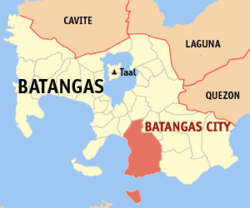Batangas City
| Batangas City | ||
|---|---|---|
| Component City | ||

View of Poblacion, Batangas City, from Gulod Labac
|
||
|
||
| Nickname(s): "Industrial Port of Calabarzon"; Eco Tourist City of the Past, Present and Future | ||
| Motto: "All here So near" | ||
 Location in the province of Batangas |
||
| Location within the Philippines | ||
| Coordinates: 13°45′N 121°03′E / 13.75°N 121.05°ECoordinates: 13°45′N 121°03′E / 13.75°N 121.05°E | ||
| Country | Philippines | |
| Region | CALABARZON (Region IV-A) | |
| Province | Batangas | |
| Congr. District | Lone District of Batangas City | |
| Founded | March 10 1917 | |
| Cityhood | July 23, 1969 | |
| Barangays | 105 | |
| Government | ||
| • Mayor | Beverly A. Dimacuha-Mariño(Liberal) | |
| • Vice Mayor | Emilio Francisco A. Berberabe Jr. (UNA) | |
| • Representative | Mario Vittorio A. Mariño | |
| • Councilors |
List
|
|
| Area | ||
| • City | 282.96 km2 (109.25 sq mi) | |
| Elevation | 477 m (1,565 ft) | |
| Population (2015 census) | ||
| • City | 329,874 | |
| • Density | 1,200/km2 (3,000/sq mi) | |
| Demonym(s) | Batangueño (male) Batangueña (female) |
|
| Time zone | PST (UTC+8) | |
| ZIP code | 4200 | |
| IDD : area code | +63 (0)43 | |
| Income Class | First | |
| Feast | January 16 | |
| Website | www |
|
Batangas City (Filipino: Lungsod ng Batangas), is the largest and capital city of the Province of Batangas, Philippines. Known as the "Industrial Port City of Calabarzon", Batangas City is currently classified as one of the fastest urbanizing cities of the Philippines. According to the 2015 census, the city has a population of 329,874 people.
The first Spanish missionaries arrived in Batangas City since 1572 due to group migration. Finally, in 1581, Spanish authorities governing the Philippines created a pueblo in the area which included the hill (now Hilltop) where the present Provincial Capitol of Batangas stands after the formal end of the Coumintang Kingdom. The town was named "Batangan" because huge logs, locally called "batang", abounded in the place. The Spanish government appointed Don Agustin Casilao as Batangan's first gobernadorcillo. Said title of "little governor" as head of the pueblo or municipio was replaced in 1894 by "capital municipal." It is not clear who succeeded Casilao nor is it known whether there were subsequent appointments of capital municipal. Don Agustin Casilao is sometimes referred to as Agustino or Augustino in some sources. By 1870, its barangays were Balagtas, Bilogo, Bolbok, Bukal, Catandala, Konde, De La Paz, Kumintang Ibaba, Matuko, Mapagong, Paharang Kanluran, Pairang, Pinamucan, Patulo, Sampaga, San Agapito, San Isidro ang Talahib.
At the coming of the Americans in the early 1900s, local civil government of Batangas was set up. It took effect on July 4, 1901 with Jose Villanueva elected as "Municipal President." His term expired in 1903.
Subsequent elections installed the following as municipal presidents: Juan Palacios, 1904–1905; Jose Arguelles, 1906; Marcelo Llana, 1907; Sisenando Ferriols, 1908–1909; Ventura Tolentino, 1910–1914; Julian Rosales, 1915; Juan Gutierrez, 1916–1919; Julian Rosales, 1920–1922; Juan Buenafe, 1923–1930; Perfecto Condez, 1931–1937; Juan Buenafe, 1938-1940. In 1941 the title "Municipal President" was changed to "Municipal Mayor." Pedro Berberabe was elected first municipal mayor.
Batangas City was severely damaged due to the Japanese A6M Zero bombardment and on December 12, 1941, the Batangas Airport which is located in Brgy. Alangilan is totally destroyed. On October 14, 1943, municipal councilor Roman L. Perez was appointed Mayor by the Japanese after the inauguration of the Second Republic of the Philippines. Liberation begun when 158th Regimental Combat Team (or 158th RCT) under the command of the US 6th Army reached Poblacion, Batangas City by March 11 during the Philippines Liberation Campaign of 1944–45. By the end of April the same that year, some elements of the 188th Glider Infantry Regiment of the 11th Airborne Division was left to clear the barangays east and mountains south of the city as the main Allied Force continued their drive towards the Quezon Province. Some of hundreds thousands local Filipino soldiers and officers of the 4th and 42nd Infantry Division of the Philippine Commonwealth Army and 4th Infantry Regiment of the Philippine Constabulary was entering and re-invaded in Batangas City. Throughout the battle, recognized Filipino Guerrilla fighters played an important key role in the advancement of the combined American and Philippine Commonwealth troops, providing key roads and information for the Japanese location of defenses and movements. Hostilities ended as the war came closer to the end.
...
Wikipedia


